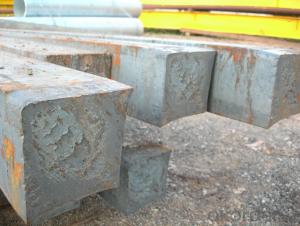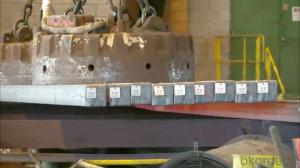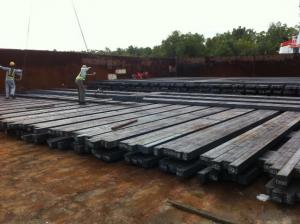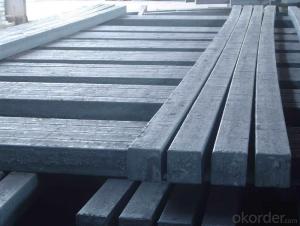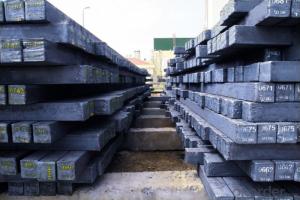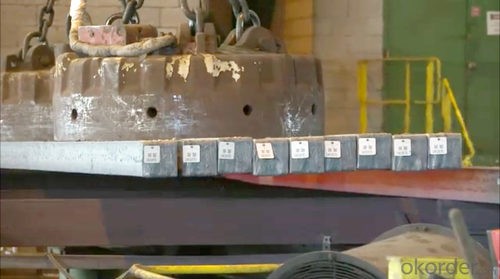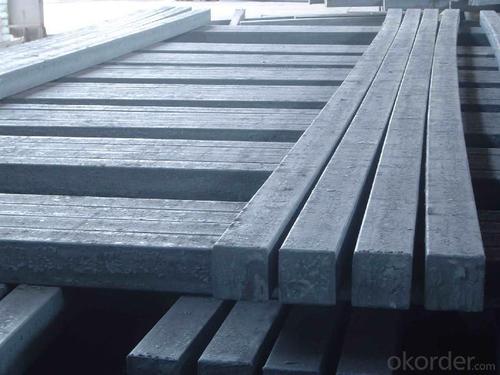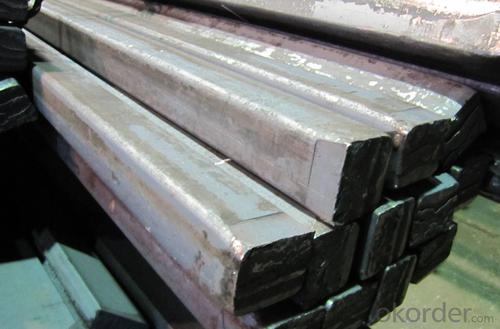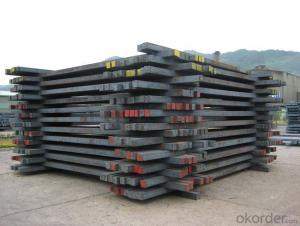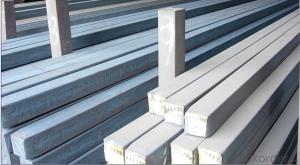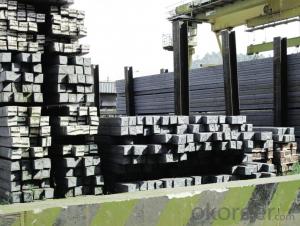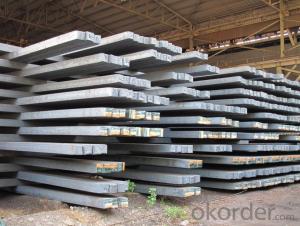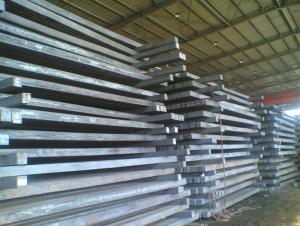Hot Rolled Square Steel Billet 3SP Standard 140mm
- Loading Port:
- Shanghai
- Payment Terms:
- TT OR LC
- Min Order Qty:
- 2000 m.t.
- Supply Capability:
- 10000 m.t./month
OKorder Service Pledge
OKorder Financial Service
You Might Also Like
Structure of Hot Rolled Square Steel Billet 3SP Standard 140mm
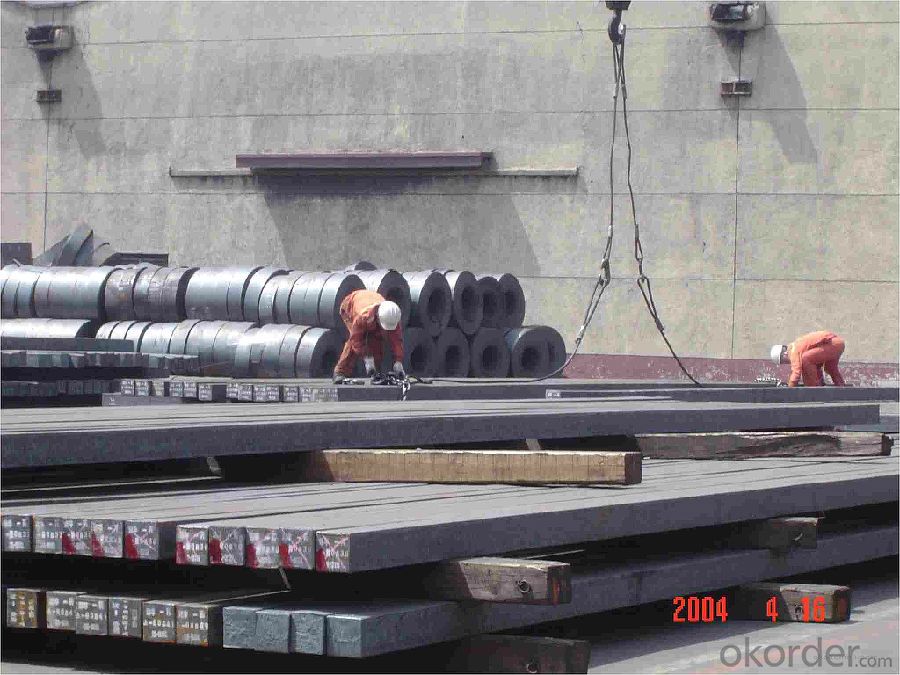
Description of Hot Rolled Square Steel Billet 3SP Standard 140mm
PPGI is made by cold rolled steel sheet and galvanized steel sheets as baseplate, through the surface pretreatment (degreasing, cleaning, chemical conversion processing), coated by the method of continuous coatings (roller coating method),
and after roasting and cooling. Zinc coating: Z60, Z80, Z100, Z120, Z180, Z275, G30, G60, G90
Alu-zinc coating: AZ60, AZ80, AZ100, AZ120, AZ180, G30, G60, G90
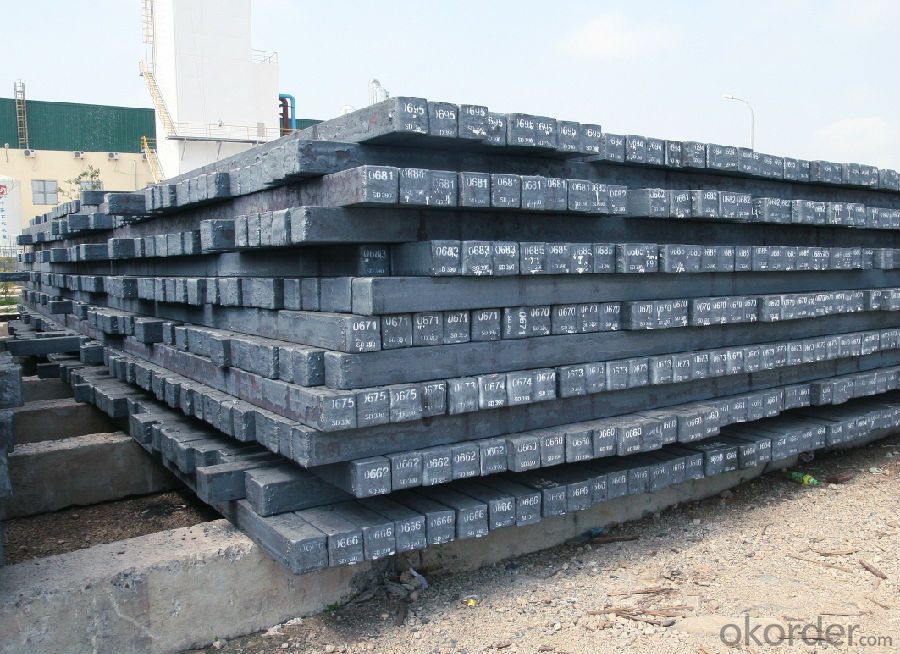
Main Feature of Hot Rolled Square Steel Billet 3SP Standard 140mm
1) Excellent corrosion resistance: The zinc layer provides a good protection of Pre-painted Galvanizeed Steel Sheet.
2) High heat resistance: The reflective surface of the material aids in efficiently reflecting the sunlight away and in turn reducing the amount of heat transmitted. The thermal reflectivity converts into energy savings.
3) Aesthetics: Pre-Painted Galvanized steel sheet is available in plethora of patterns and multiple sizes as per the requirements that given by our customers.
4) Versatility: can be used in the various areas.Standard seaworthy export packing: 3 layers of packing, inside is kraft paper, water plastic film is in the middle and outside GI steel sheet to be covered by steel strips with lock, with inner coil sleeve.
Applications of Hot Rolled Square Steel Billet 3SP Standard 140mm
1) Automotive bodies: filters, fuel tanks, etc.
2) Construction materials: roofings, welding pipes,
3) Electric and electronic appliances: computer cans, etc.
4) Steel cans: containers, etc.
5) Steel furniture: washing machines, refrigerators, microwaves, etc.
6) Drums
7) Office equipment: printer, recorders, etc.
8) Motors and transformers
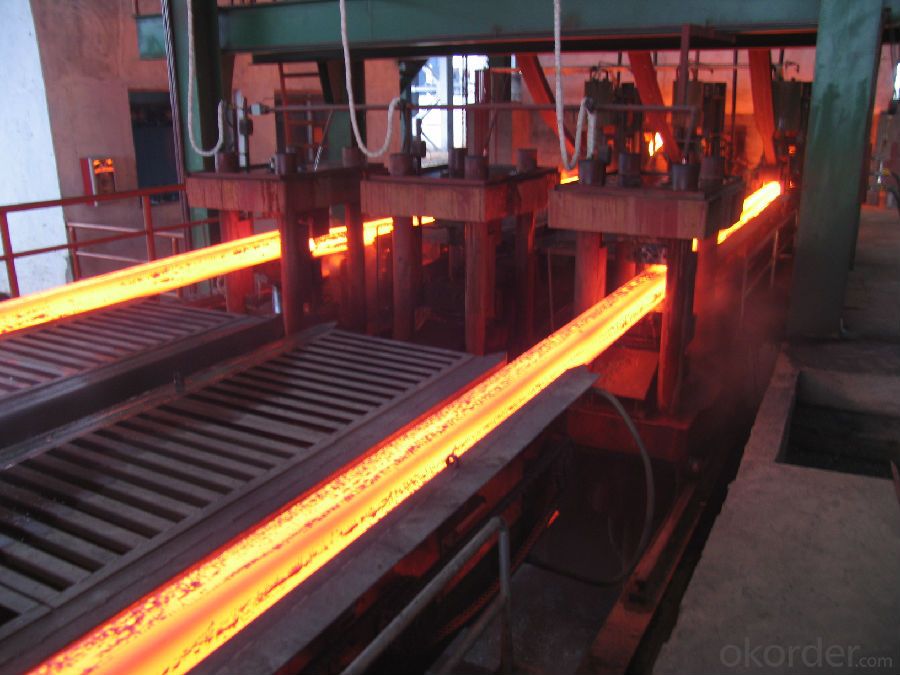
Specifications of Hot Rolled Square Steel Billet 3SP Standard 140mm
| Classified symbol | Yield Point Minimum N/mm2 | Tensile Strength Minimum | Elongation Minimum % | Application | ||||
| N/mm2 | Nominal Thickness mm (t) | |||||||
| JIS | Yogic | 0.25-0.4 | 0.4-0.6 | 0.6-1.0 | 1.0-1.6 | |||
| G3312 | specification | |||||||
| CGCC | CGCC | -205 | -270 | -20 | -21 | -24 | -24 | Commercial |
| CGCD | CGCD | --- | 270 | --- | 27 | 31 | 32 | Drawing |
| --- | CG340 | 245 | 340 | 20 | 20 | 20 | 20 | Structural |
| CGC400 | CG400 | 295 | 400 | 16 | 17 | 18 | 18 | Structural |
| CGC440 | CG440 | 335 | 440 | 14 | 15 | 16 | 18 | Structural |
| CGC490 | CG490 | 365 | 490 | 12 | 13 | 14 | 16 | Structural |
| CGC570 | CG570 | 560 | 570 | --- | --- | --- | --- | Structural |
| ASTM Designation | Yield Point Minimum | Tensile Strength Minimum | Elongation Minimum % | Application | Q/BQB 445-2004(China standard) | ASM A653/A653M | JISG 3312 | |
| ksi(MPa) | ksi(MPa) | TDC51D+Z | (CS TYPE A+Z) | CGCC | ||||
| A653(M)-99 CS TYPE A,B,C | --- | --- | --- | Commercial | TDC52D+Z | CGCD | ||
| A653(M)-99 FS | --- | --- | --- | Lock Forming | TS250GD+Z | (G250+Z) | - | |
| A653(M)-99 DS | --- | --- | --- | Drawing | TS300GS+Z | (G300+Z) | CGC 400 | |
| A653(M)-99 SS Grade33(230) | 33(230) | 45(310) | 20 | Structural | TS350GD+Z | (G350+Z) | CGC490 | |
| A653(M)-99 SS Grade37(255) | 37(255) | 52(360) | 18 | Structural | TS550GD+Z | (G550+Z) | CGC570 | |
| A653(M)-99 SS Grade40(275) | 40(275) | 55(380) | 16 | Structural | ||||
| A653(M)-99 SS Grade50(345) | 50(345) | 65(450) | 12 | Structural | ||||
| A653(M)-99 SS Grade80(550) | 80(550) | 82(570) | --- | Structural | ||||
FAQ of Hot Rolled Square Steel Billet 3SP Standard 140mm
We have organized several common questions for our clients,may help you sincerely:
1. How Can I Visit There?
Our company is located in Tianjin City, China, near Beijing. You can fly to Tianjin Airport Directly. All our clients, from home or aboard, are warmly welcome to visit us!
2. How Can I Get Some Sample?
We are honored to offer you sample.
3. Why choose CNBM?
1, ISO, BV, CE, SGS approved.
2, Competitive price and quality.
3, Efficient service team online for 24 hours.
4, Smooth production ability(50000tons/month) .
5, quick delivery and standard exporting package.
6, Flexible payment with T/T, L/C, Paypal, Kunlun bank, etc.
- Q: What are the different types of surface finishes available for steel billets?
- There are several different types of surface finishes available for steel billets, each serving a specific purpose and offering unique characteristics. Some of the most common surface finishes for steel billets include: 1. Hot Rolled: This is the most basic surface finish, achieved by heating the steel billet above its recrystallization temperature and then rolling it to the desired shape and size. Hot rolled steel billets have a rough and scaled surface, which is suitable for applications where aesthetics are not a primary concern. 2. Cold Rolled: This surface finish is obtained by further processing the hot rolled billets through a series of cold rolling processes. Cold rolled steel billets have a smoother and more refined surface, with tighter tolerances and improved dimensional accuracy. 3. Pickled and Oiled: This surface finish involves removing any rust, scale, or mill scale from the steel billets by immersing them in an acidic solution, commonly known as pickling. After pickling, the steel billets are oiled to provide temporary corrosion protection. This finish is ideal for applications where cleanliness and corrosion resistance are crucial. 4. Galvanized: Galvanizing is a surface finishing process that involves coating the steel billets with a layer of zinc to provide enhanced corrosion resistance. This finish is particularly suitable for outdoor applications or environments with high humidity, where the steel needs protection against rust and corrosion. 5. Electroplated: Electroplating is a process where a thin layer of metal, such as nickel or chromium, is deposited onto the steel billets through an electrochemical reaction. This surface finish provides improved aesthetics, enhanced corrosion resistance, and can also offer specific functional properties, such as hardness or wear resistance. 6. Powder Coated: Powder coating is a surface finishing technique where a dry powder is electrostatically applied to the steel billets and then cured under heat to form a durable and protective coating. This finish offers excellent corrosion resistance, impact resistance, and a wide range of color options, making it popular in architectural and decorative applications. 7. Anodized: Anodizing is a surface treatment commonly used for aluminum, but it can also be applied to steel billets. This process involves creating an oxide layer on the surface of the steel by subjecting it to an electrolytic process. Anodized steel billets exhibit improved corrosion resistance, increased hardness, and can be dyed in various colors for aesthetic purposes. These are just a few examples of the different types of surface finishes available for steel billets. The choice of finish depends on the specific requirements of the application, including aesthetics, corrosion resistance, durability, and functional properties.
- Q: Can steel billets be used in the production of appliances?
- Yes, steel billets can be used in the production of appliances. Steel billets, which are semi-finished products of steel, can be further processed and shaped into various components and parts that are used in appliances manufacturing. The high strength and durability of steel make it a suitable material for appliances, providing stability and reliability to the finished products.
- Q: What are the different surface treatments for improved fatigue resistance in steel billets?
- Some of the different surface treatments that can improve fatigue resistance in steel billets include shot peening, nitriding, and induction hardening. Shot peening involves bombarding the surface of the billets with small steel shots, which creates compressive stresses that help to increase fatigue strength. Nitriding is a process where the steel billets are exposed to nitrogen gas at high temperatures, forming a hard nitride layer on the surface which improves both hardness and fatigue resistance. Induction hardening involves heating the surface of the billets using high-frequency currents and then rapidly quenching it, resulting in a hardened surface layer that enhances fatigue resistance.
- Q: What are the properties of alloy steel billets?
- Alloy steel billets possess a combination of properties that make them highly desirable for various applications. These properties include high strength, excellent hardness and wear resistance, good toughness, and improved corrosion resistance compared to carbon steel. Additionally, alloy steel billets have the ability to withstand high temperatures and exhibit excellent machinability, making them ideal for use in industries such as automotive, aerospace, construction, and manufacturing.
- Q: What are the main factors affecting the ductility of steel billets?
- The main factors affecting the ductility of steel billets are the composition of the steel, the temperature at which it is processed, and the amount of strain applied during shaping.
- Q: What are the main challenges in sourcing steel billets?
- Sourcing steel billets presents several primary challenges. First and foremost, a crucial challenge lies in securing a dependable and consistent supply of high-quality steel billets. Typically, steel billets are obtained from steel mills or manufacturers, necessitating the identification of suppliers capable of consistently meeting the required specifications and standards. This entails conducting extensive research and due diligence to locate reputable and reliable suppliers with a proven track record of producing top-notch billets. Another challenge involves effectively managing the costs and price fluctuations associated with steel billets. Steel prices are influenced by various factors, including global demand, raw material expenses, and market dynamics. Consequently, the price of steel billets can be unstable, impacting procurement decisions and budgets. Sourcing professionals must meticulously monitor market trends and negotiate pricing agreements to ensure optimal value for their organization. Furthermore, logistics and transportation pose challenges when sourcing steel billets. Given their weight and bulk, transporting and managing the logistics of steel billets can be complex. Coordinating deliveries, overseeing shipping schedules, and ensuring timely arrival of the billets can prove challenging, especially when dealing with international suppliers. It is crucial to collaborate closely with reliable logistics partners and implement a robust supply chain management system to overcome these obstacles. Maintaining quality control is another critical aspect of sourcing steel billets. Given the vital role steel plays in various industries, it is imperative to guarantee that the billets meet the required quality standards. This entails conducting quality inspections, reviewing certifications, and performing material testing to verify the integrity and properties of the billets. Regular audits and inspections should be conducted to ensure consistent quality throughout the sourcing process. Lastly, regulatory compliance and trade restrictions present challenges in sourcing steel billets. Import/export regulations, tariffs, and trade barriers can impact the availability and cost of steel billets from specific regions. Sourcing professionals must stay updated on the latest regulations and trade policies to navigate these challenges and ensure compliance with applicable laws. In conclusion, the primary challenges in sourcing steel billets encompass securing a consistent supply of high-quality billets, managing price fluctuations, handling logistics and transportation, maintaining quality control, and complying with regulatory requirements. Overcoming these challenges necessitates careful supplier selection, effective negotiation, robust supply chain management, and staying informed about market trends and regulations.
- Q: Are steel billets used in the manufacturing of industrial machinery?
- Commonly used in the manufacturing of industrial machinery are steel billets. These semi-finished products are typically produced through continuous casting. They serve as the raw material for various types of machinery, including heavy-duty equipment, construction machinery, and machine tools. Industrial machinery prefers steel due to its strength, durability, and resistance to wear and tear. Steel billets often serve as the starting material for processes such as forging, rolling, or machining to create specific components required for machinery. These components encompass gears, shafts, frames, brackets, and other structural parts. Steel possesses high-quality properties, including high tensile strength and excellent mechanical properties, making it an ideal material for enduring demanding conditions and heavy loads in industrial machinery. Furthermore, steel's easy weldability and machinability allow manufacturers to produce intricate and precise parts for machinery. In summary, steel billets play a vital role in the manufacturing of industrial machinery. They provide the necessary raw material to create robust and dependable components capable of withstanding the challenges posed by various industrial applications.
- Q: Can steel billets be used in the production of consumer electronics?
- Typically, steel billets aren't utilized in the production of consumer electronics. These semi-finished steel products are commonly employed as raw materials in manufacturing other steel products like bars, rods, and pipes. Conversely, consumer electronics are typically manufactured using diverse materials like plastics, metals such as aluminum and copper, and electronic components like circuit boards and semiconductors. Although steel may be utilized in certain components of consumer electronics, like the casing or frame, it is typically in a more refined form such as sheet metal or extruded profiles, rather than steel billets.
- Q: What are the different types of steel billet reheating furnaces?
- There are several types of steel billet reheating furnaces, including walking beam furnaces, pusher furnaces, rotary hearth furnaces, and roller hearth furnaces. Each type has its own advantages and uses, depending on the specific requirements of the steel production process.
- Q: What are the different forging techniques used for steel billets?
- Steel billets can be forged using various techniques, each with its own benefits and results. Some commonly employed methods for forging steel billets are: 1. Open Die Forging: By placing the steel billet between two flat dies and applying compressive force, it can be shaped. This technique allows for the formation of a wide range of shapes and is often used for large and intricate components. 2. Closed Die Forging: Also known as impression die forging, this method utilizes specially shaped dies with impressions of the desired final shape. The steel billet is positioned between the dies and compressed to conform to the cavities. Closed die forging provides precise control over the shape and dimensions of the end product. 3. Roll Forging: Here, the steel billet is passed through rotating rolls that exert compressive force to shape it. Roll forging is commonly employed for the production of long cylindrical shapes like bars, rods, and shafts. 4. Upset Forging: This technique involves axial compression of the steel billet to increase its cross-sectional area and reduce its length. Upset forging is often used to create thicker sections or increase the material's diameter. 5. Press Forging: Hydraulic or mechanical presses are used in press forging to apply force to the steel billet, shaping it against the die. This method enables precise control over the forging process, making it suitable for intricate shapes or close tolerances. 6. Swaging: Swaging is a forging technique where the diameter of a steel billet is reduced by applying radial compressive force using a series of dies. This process is commonly employed to produce tapered or pointed components like pins, bolts, or needles. Each of these forging techniques offers unique advantages depending on the desired shape, size, and properties of the final product. The choice of forging technique is determined by factors such as part complexity, material properties, production volume, and cost considerations.
Send your message to us
Hot Rolled Square Steel Billet 3SP Standard 140mm
- Loading Port:
- Shanghai
- Payment Terms:
- TT OR LC
- Min Order Qty:
- 2000 m.t.
- Supply Capability:
- 10000 m.t./month
OKorder Service Pledge
OKorder Financial Service
Similar products
Hot products
Hot Searches
Related keywords
